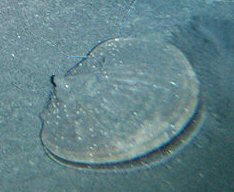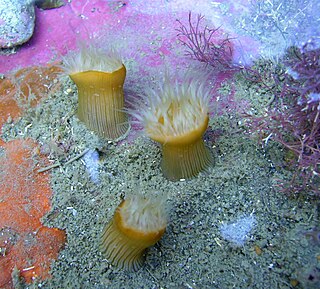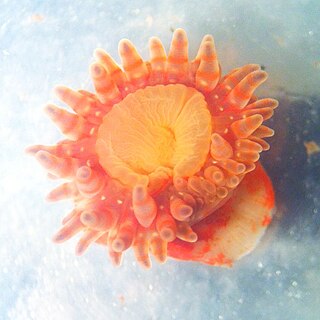
Nudibranchs are a group of soft-bodied marine gastropod molluscs which shed their shells after their larval stage. They are noted for their often extraordinary colours and striking forms, and they have been given colourful nicknames to match, such as "clown", "marigold", "splendid", "dancer", "dragon", or "sea rabbit". Currently, about 3,000 valid species of nudibranchs are known.

Anthozoa is a class of marine invertebrates which includes the sea anemones, stony corals and soft corals. Adult anthozoans are almost all attached to the seabed, while their larvae can disperse as part of the plankton. The basic unit of the adult is the polyp; this consists of a cylindrical column topped by a disc with a central mouth surrounded by tentacles. Sea anemones are mostly solitary, but the majority of corals are colonial, being formed by the budding of new polyps from an original, founding individual. Colonies are strengthened by calcium carbonate and other materials and take various massive, plate-like, bushy or leafy forms.

A tide pool or rock pool is a shallow pool of seawater that forms on the rocky intertidal shore. Many of these pools exist as separate bodies of water only at low tide.
Nacella macquariensis is a species of true limpet, a marine gastropod mollusc in the family Nacellidae. It is found on the lower foreshore and in the shallow sub-littoral zone of certain islands in the southern Indian Ocean and Southern Ocean.

Durvillaea antarctica, also known as cochayuyo and rimurapa, is a large, robust species of southern bull kelp found on the coasts of Chile, southern New Zealand, and Macquarie Island. D. antarctica, an alga, does not have air bladders, but floats due to a unique honeycomb structure within the alga's blades, which also helps the kelp avoid being damaged by the strong waves.

Corynactis californica is a brightly colored colonial anthozoan corallimorph. Unlike the Atlantic true sea anemone, Actinia fragacea, that bears the same common name, strawberry anemone, this species is a member of the order Corallimorpharia, and is the only member found in the North American West Coast. Other common names include club-tipped anemone and strawberry corallimorpharian. The anemone can live up to at least 50 meters deep on vertical rock walls, and at the bottom of kelp forests. It is known to carpet the bottom of some areas, like Campbell River in British Columbia, and Monterey Bay in California.

Sea anemones are a group of predatory marine animals of the order Actiniaria. Because of their colourful appearance, they are named after the anemone, a terrestrial flowering plant. Sea anemones are classified in the phylum Cnidaria, class Anthozoa, subclass Hexacorallia. As cnidarians, sea anemones are related to corals, jellyfish, tube-dwelling anemones, and Hydra. Unlike jellyfish, sea anemones do not have a medusa stage in their life cycle.

Nemanthus annamensis, commonly known as the gorgonian wrapper, is a species of sea anemone found in central Indo-Pacific waters.

Flustra foliacea is a species of bryozoans found in the northern Atlantic Ocean. It is a colonial animal that is frequently mistaken for a seaweed. Colonies begin as encrusting mats, and only produce loose fronds after their first year of growth. They may reach 20 cm (8 in) long, and smell like lemons. Its microscopic structure was examined by Robert Hooke and illustrated in his 1665 work Micrographia.

Odontaster validus is a species of sea star in the family Odontasteridae. Its range includes the Southern Ocean and the seas around the mainland and islands of Antarctica.

The Antarctic scallop is a species of bivalve mollusc in the large family of scallops, the Pectinidae. It was thought to be the only species in the genus Adamussium until an extinct Pliocene species was described in 2016. Its exact relationship to other members of the Pectinidae is unclear. It is found in the ice-cold seas surrounding Antarctica, sometimes at great depths.

Gorgonia ventalina, the common sea fan and purple sea fan, is a species of sea fan, an octocoral in the family Gorgoniidae. It is found in the western Atlantic Ocean and the Caribbean Sea.

Anthothoe albocincta, or white-striped anemone, is a species of sea anemone in the family Sagartiidae. It is native to the coasts of Australia and New Zealand.
Lobophora variegata is a species of small thalloid brown alga which grows intertidally or in shallow water in tropical and warm temperate seas. It has three basic forms, being sometimes ruffled, sometimes reclining and sometimes encrusting, and each form is typically found in a different habitat. This seaweed occurs worldwide. It is the type species of the genus Lobophora, the type locality being the Antilles in the West Indies.
Amathia verticillata, commonly known as the spaghetti bryozoan, is a species of colonial bryozoans with a bush-like structure. It is found in shallow temperate and warm waters in the western Atlantic Ocean and the Caribbean Sea and has spread worldwide as a fouling organism. It is regarded as an invasive species in some countries.

Stomphia coccinea is a small reddish, orange or brownish sea anemone in the family Actinostolidae from the North Atlantic, North Pacific and Arctic Ocean. It can swim away when necessary in order to escape a predator.
Urticinopsis antarctica is a species of sea anemone in the family Actiniidae. It is found in the Southern Ocean around Antarctica.

Gonactinia is a monotypic genus of sea anemones, and G. prolifera is the only species in the genus. It is sometimes called the storey anemone and is found on either side of the northern Atlantic Ocean.
Tritoniella is a genus of sea slugs, specifically dendronotid nudibranchs. It is a marine gastropod mollusc in the family Tritoniidae.The genus was described in 1907 by the British diplomat and malacologist Charles Eliot.
Clavularia frankliniana is a species of colonial soft coral in the family Clavulariidae. It is found in the southern Atlantic Ocean and the waters around Antarctica. It was first described in 1902 by the French zoologist Louis Roule.













